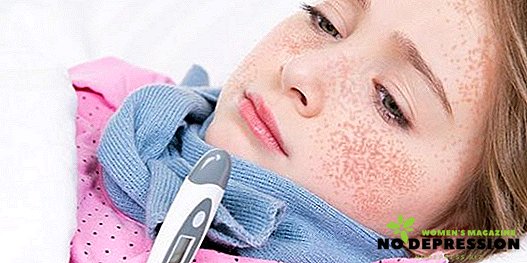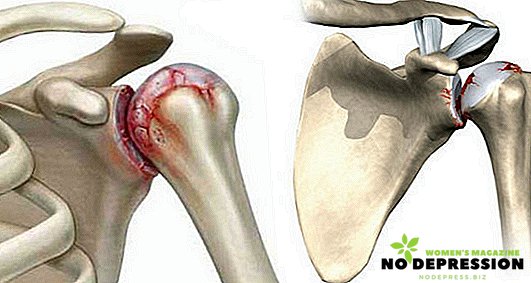Scarlet fever is an acute infectious disease characterized by fever, sore throat, general intoxication of the body, and profuse rash. Babies in the age group from 2 to 10 years are most susceptible to the disease.
Scarlet fever develops due to group A streptococcus entering the human body. Infection occurs due to the lack of immunity to this type of disease.

Causes of scarlet fever, transmission routes
Streptococcus group A, falling on the mucosa of the nasopharynx of the child, begins to actively develop and affects both the nasopharynx itself and the skin, as well as internal organs. The danger is not the streptococcus itself, but the toxin that it releases during its vital activity in the human body.
Getting on the mucous membrane of the mouth and nose (less often - through wounds on the skin), streptococcus begins active reproduction, causes sore throat, emit toxic substances that get into other organs and systems of the body.
Affected heart, nervous system, kidneys. There is a general poisoning of the body with toxins.
According to statistics, from 15 to 20% of people who seem to be outwardly completely healthy, are carriers of streptococcus group A. The disease is highly infectious, it is believed that a person can be its carrier for another 22 days from the onset of the first symptoms. The incubation period lasts from 1 to 12 days, in most cases it is 2-4 days.
Infection occurs directly from a sick person with any form of streptococcal infection (tonsillitis, rheumatism, scarlet fever). Streptococcus transmission occurs through airborne droplets. In a person who had had scarlet fever once, immunity is formed for the rest of his life, re-infection is impossible. The peak of the disease occurs in the autumn-winter period.
Scarlet fever in children: symptoms of the initial stage and general
Diagnosing scarlet fever during the incubation period can be quite difficult. This will require a series of laboratory tests taken.
The child may complain of general malaise, be lethargic, feel weak and have a little sore throat. Nasopharyngeal mucosa is red. But during this time, the disease begins to develop rapidly and a maximum in a day its active stage will begin.
The following processes occur:
- a sharp increase in temperature from 38 degrees or more;
- severe sore throat;
- child loses appetite;
- weakness, lethargy appear, the baby is capricious;
- tonsils markedly enlarged, red with the rest of the throat.
At this stage, scarlet fever is also difficult to diagnose, because the symptoms are similar to catarrhal tonsillitis. Characteristic for scarlet fever symptoms begin to manifest on the second day after infection. These include:
- Rash. Under the influence of toxic toxic substances released by streptococci, the skin becomes covered with a rash in the form of small red dots. Initially, the rash appears on the upper part of the chest, then spreads to the neck and face, as well as to the natural folds. The child's cheeks become red, the lips become bright crimson, and the skin near the nose and lips are pale. The rash is accompanied by itching, delivering extra discomfort to the child.
- The rash spreads to the tonsils and mucous membrane of the throat.
- The tongue in the first few hours (days) of the disease is covered with white bloom with a shade of gray. Further, in the process of development of scarlet fever, the bloom gradually comes off, a bright red surface giving way to it, smooth and shiny.

Gradually, along with the recovery of the child, all the above symptoms disappear. Only timely diagnosis and proper treatment can reduce the manifestation of unpleasant side effects of scarlet fever, as well as prevent toxins from other internal organs.
Visual examination of the throat of a child with scarlet fever
Let us consider in detail how a baby’s throat looks like with scarlet fever and how long a sore throat lasts. When visually inspecting a child with scarlet fever, the throat, its back wall, tonsils, palatine arches, and soft palate have a bright, pronounced red hue.
In angina, the mucous membranes are not of such a pronounced color. In other words, such a symptom of scarlet fever is called "flaming throat." The bright red hue has a clear border that extends between the soft and hard sky.
The tongue is covered with a white coating with a shade of gray, which is absent in the case of angina. In more severe cases of lesions of the mucous membrane of scarlet fever, you can see purulent foci, tissue necrosis. In this condition, the sore throat can be from 3 to 5 days.
On palpation, there is a painful swelling of the lymph nodes. After 5 days after infection, crimson hue acquires language. It persists for 7-14 days. Lips also become painted in bright scarlet color.

Scarlet fever rash
A rash in a scarlet fever patient occurs 2-3 days after infection. Manifested in the form of red small dots. In the folds of the body of the rash give way to red stripes. Rashes appear on the following areas of the body:
- on the face (temples, forehead, cheeks);
- on the upper chest;
- on the folds of the arms;
- on the inner thighs;
- in the groin;
- in axillary places.
The rash can be combined into large spots. Around the lips and wings of the nose, the skin is not covered with rashes, has a pale shade.
This skin condition persists from 3 days to a week. The recovery process is accompanied by peeling, falling off of the particles of the rash.
Forms of manifestation of the disease
Scarlet fever in children in the form of manifestation is divided into pharyngeal and extrapharyngeal. Each of them is typical or atypical.
A typical form is classified according to the following types:
- Mild form - body temperature rarely exceeds 38.5 degrees, rashes on the skin are minor, sore throat is not strong. The mild form lasts from 4 to 5 days.
- The average form - it is characterized by high body temperature, widespread rash on the skin, purulent tonsillitis, signs of general intoxication (weakness, lethargy, decreased appetite), vomiting. This form lasts from 6 to 8 days.
- The severe form of scarlet fever is subdivided into:
- toxic - is characterized by extreme intoxication of the body up to toxic shock. The temperature can rise to 41 degrees, there is a violation of the mental state, manifested in the form of delusions and hallucinations, loss of consciousness. Toxic scarlet fever disrupts the heart;
- septic - it is characterized by necrotic tonsillitis, inflammation spreads to all adjacent tissues;
- toxic-septic - combines the symptoms of the septic and toxic forms described above.
Extrafaryngeal form is accompanied by lymphadenitis (inflammation of the lymph nodes).
Diagnosis of the disease, methods of traditional and traditional medicine for the treatment
It is possible to diagnose the disease if the symptomatic data are correctly collected from the patient's words. Usually the child complains of vomiting and pain when swallowing.
There is a sharp rise in temperature to high values, a small rash over the body, in the folds is presented in the form of stripes, the tongue acquires a crimson hue, the face becomes red with a white area around the lips and wings of the nose. Lymph nodes are enlarged.
 The specialist makes an accurate diagnosis only after conducting a series of laboratory tests of blood taken. The analysis will show a high content of neutrophils and leukocytes, as well as accelerated ESR.
The specialist makes an accurate diagnosis only after conducting a series of laboratory tests of blood taken. The analysis will show a high content of neutrophils and leukocytes, as well as accelerated ESR.
Streptococcus group A is determined by seeding mucus from the pharynx. For help, you will need to consult an infectious diseases specialist.
Recently, the treatment of children produced at home, because the infection in recent years has reduced its severe impact on the body. Only children whose body has obvious signs of toxic poisoning or serious chronic diseases that can be exacerbated by scarlet fever are subject to hospitalization.
When manifestations of the first symptoms of the disease, you must call an ambulance or a doctor to the house because of the high infectiousness. Before arrival of the doctor it is necessary to provide the child with bed rest. The throat is subject to frequent rinsing, which will prevent further development of the infection.
For rinsing use a solution of soda and salt, anti-inflammatory decoctions and herbal infusions, antiseptics (such as furatsilin and chlorophyllitis). To reduce the toxic effects of toxins on the body, they give plenty of drinks with a high content of vitamin C.
Medications may be prescribed only by the attending physician. Antibacterial agents created for the treatment of scarlet fever: smallpox, cephalexin, erythromycin and amoxiclav. To avoid side effects of antibiotics, prescribe antihistamines.
 The type of drugs, their dosage and combination can be established only by the attending physician, depending on the age of the child, the presence of chronic diseases and the severity of scarlet fever.
The type of drugs, their dosage and combination can be established only by the attending physician, depending on the age of the child, the presence of chronic diseases and the severity of scarlet fever.
Alternative medicine methods for the treatment of scarlet fever must be approved by a physician. They are aimed at combating streptococcus, as well as to alleviate the symptoms and reduce the toxic effects of toxins on the body.
The most popular means in the fight against scarlet fever is considered to be cedar branches, brewed with boiling water. For infusion take from 5 to 10 tablespoons of finely chopped tree branches with needles, pour about 0.7 liters of boiling water and allow to infuse for 10 hours. Drink infusion during the day instead of other drinking. The course of treatment can vary from 3 to 6 months.
Parsley is a good tool in the fight against scarlet fever in a child. Take a tablespoon of parsley, pour a glass of boiling water and give the baby 3 times a day, one tablespoon. For gargling throat suitable cranberry juice, heated to body temperature.
Advice of Dr. Komarovsky in the treatment of scarlet fever in children
The recommendations of the famous pediatrician Komarovsky for the treatment of scarlet fever in a child are aimed at taking antibiotics. The doctor advises the use of penicillin group drugs. Only they are capable of killing Streptococcus group A.
Along with antibiotics, antihistamines should be prescribed to eliminate the risk of allergic reactions. To maintain the body also give the child vitamin groups, among which vitamin C is prescribed without fail.
All medicines should be used only after the appointment of the attending physician and under his strict supervision.

Prevention of the development of the disease
Scarlet fever is a highly contagious airborne infection. The main means of protecting against infection - is the observance of basic rules of personal hygiene. These include compulsory hand washing after visiting public places, as well as before each meal.
All things of a sick child should be thoroughly washed and ironed, and the dishes from which he takes food and water are thoroughly washed with boiling water.
Any disease is dangerous for the child's body. Scarlet fever is no exception. Its toxic effects on the child’s body can cause irreparable damage to such vital organs as the heart, kidneys and nervous system. Therefore, it is important to carry out the correct diagnosis in time and prescribe proper treatment.
A little more additional information about scarlet fever from a pediatrician is in the next video.












